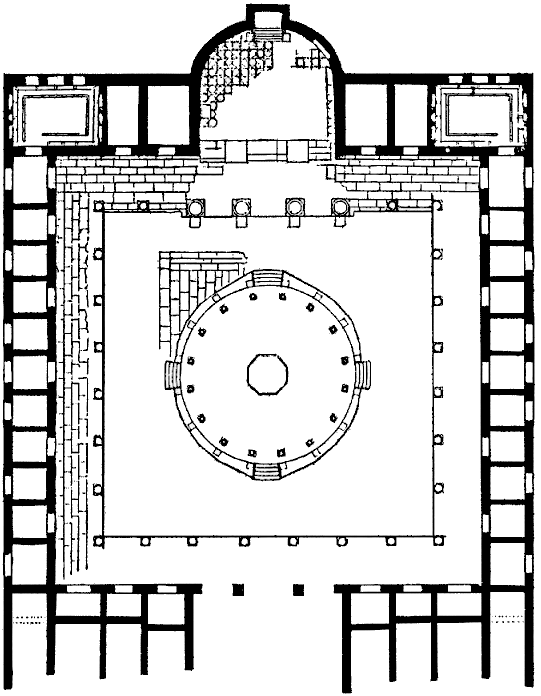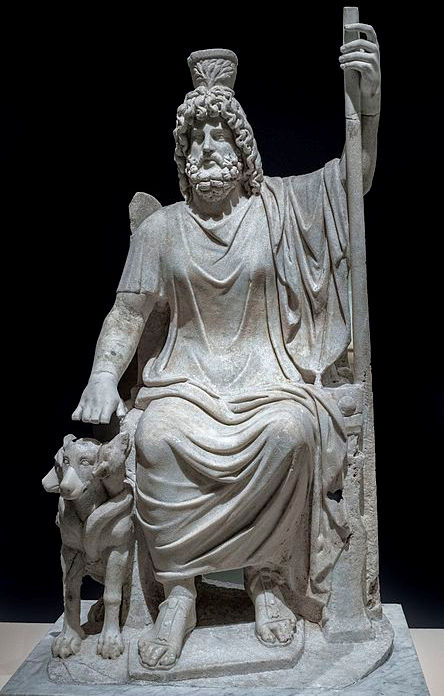Most of Puteoli is buried underneath the modern city of Pozzuoli. We therefore know little about the houses, shops, workshops and markets. A rather well-known exception is Puteoli's macellum, the central fish and meat market. The building is close to the sea. It was excavated for the first time in the years 1750-1753. A statue of Serapis was found in 1750, and the building was from then on interpreted as a Temple of Serapis until 1907, when Charles Dubois established its true function. The lay-out and several inscriptions leave no room for doubt. In the centre is a large round hall with an octagonal basin. It is surrounded by a porticus behind which are shops and two communal latrines. A large apsidal room was used as shrine.
General view of the macellum.
Photo: Wikimedia.


Plan of the macellum. De Ruyt 1977, fig. 1. The statue of Serapis. Archaeological Museum, Naples.
H. 1.15. Photo: Wikimedia, Ángel M. Felicísimo.
One of the communal latrines on an old etching.
Morghen 1769, Tav. 12.One of the inscriptions documents the inauguration by a citizen living in the Flavian period (CIL XIV, 1701). Stamps on lead water pipes attest to a second phase during the reign of Septimius Severus. The building was decorated lavishly with marble columns, floors and sculpture. This explains why it is found on the glass flasks (those who bought the flasks, filled perhaps with spa water, were less interested in being reminded of warehouses, the vegetable market and the cattle market).
Quite recently, during excavations below the city, a late-antique bakery (pistrinum) was found, preserving five millstones standing on a floor of basalt blocks.
View of the pistrinum.
Photo: ArcheoFlegrei.Several other professions are documented by the inscriptions. Conspicuously absent are inscriptions by commercial collegia, with or without the status of corpus. Such inscriptions were found in great numbers in Ostia-Portus, some with long lists of members. An exception to the rule is the corpus (negotiatorum / negotiantium ?) Heliopolitanorum. Presumably the absence reflects the growing importance of the harbours at the mouth of the Tiber, combined with a growing involvement of the Imperial government.
As to the public buildings, extensive remains above ground are preserved of a large temple that has a violent history. It had always been known that it had become part of the Duomo of Pozzuoli, because of two walled-in inscriptions with the name of the dedicator (Lucius Calpurnius, "at own cost") and the architect (Lucius Cocceius Auctus). The first inscription, much damaged, was for a long thought to contain the words templum Augusto, but after a new reading by Castagnoli these disappeared. The temple is on the spot of an older building, and many now believe it to be the Capitolium of Puteoli.
[L(ucius) C]ALPVRNIVS L(uci) F(ilius) TEMPLVM AVGVSTO CVM ORNAMENTIS D(e) S(uo) F(ecit)
or
[L(ucius] CALPVRNIVS L(uci) F(ilius) IIVIR COL(oloniae) AVG(ustae) PVT(eolanae) CVM ORNAMENTIS D(e) S(uo) R[efecit]L(ucius) COCCEIVS L(uci)
C(ai) POSTVMI L(ibertus)
AVCTVS ARCITECT(us)CIL X, 1613. CIL X, 1614; EDR169381. After a major fire in 1964 it became apparent that the walls of the Duomo enveloped the temple. It was made entirely of white marble, with Corinthian columns on the sides and the front, partly incorporated in the walls of the cella.
The side of the restored Temple of Augustus or Capitolium.
Photo: Wikimedia, Ruthven."Temple of Neptune" is the name that has in the past been given to the impressive remains of baths, built in the 2nd century AD.
The baths called Temple of Neptune.
Photo: Visitcampiflegrei.eu.The ancient names of many other buildings, still hidden, are known from inscriptions and can be found in the archive of the Sulpicii.